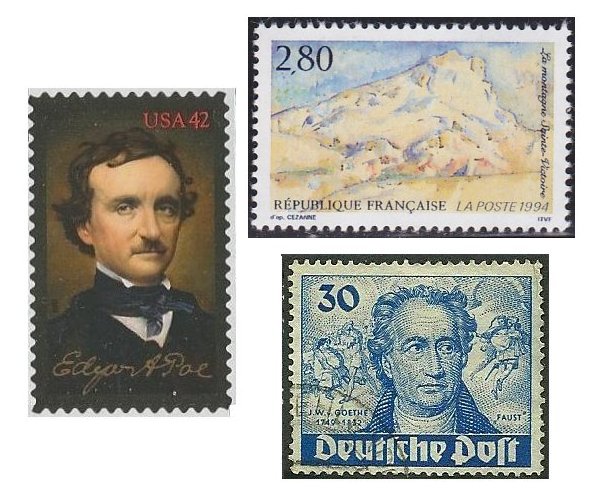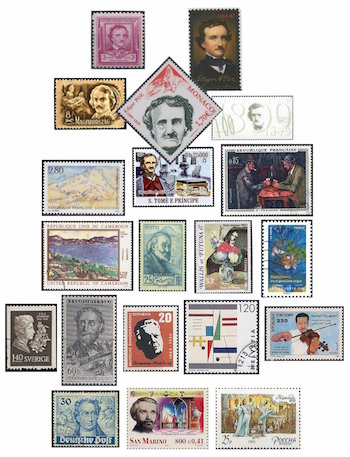The Arts on the Stamps of the World — January 19
An Arts Fuse regular feature: the arts on stamps of the world.

By Doug Briscoe
Edgar Allan Poe and Paul Cézanne share this January 19th birthday with Swedish romantic poet Per Atterbom, Czech violinist Ferdinand Laub, German conductor Hermann Abendroth, Swiss artist Sophie Taeuber-Arp, and Tunisian musician Kaddour Srarfi. Also, three works for the stage had their premieres on this date: Goethe’s Faust, Part One, Verdi’s Il trovatore, and Glazunov’s ballet Raymonda.
Edgar Allan Poe (January 19, 1809 – October 7, 1849) is so well known that I’ll limit my comments here to citing just a few of his musical offspring and to the stamps. When considering the pieces of music inspired by Poe perhaps the first thing that may come to mind is Rachmaninov’s choral work “The Bells.” Debussy left unfinished an opera based on “The Fall of the House of Usher.” There are many other settings of Poe’s prose and poesy, mostly by American and British composers. The poem “Annabel Lee” has been set about three dozen times (once by John Philip Sousa!), “Eldorado” even more often. The first Poe stamp, appropriately, was issued by the United States; this was as part of a big 1940 series honoring various American artists, scientists, educators, and inventors. Fast forward 69 years to an issue marking the bicentenary of his birth for the next US issue, along with examples from Monaco, St. Thomas, and Bulgaria from the same year. The Hungarian stamp belongs to a set of ten from 1948 devoted to great writers of various nationalities.
Of Paul Cézanne (1839 – 22 October 1906) I suppose I need likewise say little, other than that he loved to treat the same subjects in series of paintings, as evinced in the philatelic Cézanne. To the left of the St. Thomas Poe stamp we see one of the Mont Sainte-Victoire series; at right is one of the Card Players group. In the next row is one of his many views of the village of L’Estaque, this stamp coming from Cameroun. Then comes a portrait stamp of 1939 and a Vase de fleurs on a stamp from the Southern Pacific collectivity (French territory) of Wallis and Futuna. Finally, another floral work, Iris et géraniums rouges, on a stamp just issued in 2015. Most of our offerings today are stamps from France, but there are many others.
Now, for Per Atterbom (1790 – 21 July 1855) you may need a little background, unless you’re an aficionado of Swedish letters. While still a student at the university of Uppsala (where he later taught philosophy), he founded an artistic society and a few years later began to edit a journal called Fosforos, which I gather has some importance in Swedish literature. An admirer of the German poets Tieck and Novalis, Atterbom, besides his poems, also completed one drama, his masterwork, Lycksalighetens Ö (The Fortunate Island) of 1823, and left unfinished a fairy tale play, Fågel Blå (The Blue Bird). He also wrote an expansive set of biographies of Swedish men of letters. The stamp appeared on the one hundredth anniversary of his death.
Ferdinand Laub (1832 – March 17, 1875) was a Czech violinist who performed in public at the age of 6. He studied at the Prague Conservatory and taught in Weimar, Berlin, and Moscow. Tchaikovsky is said to have called him “the best violinist of our time.” Laub took part in the premières of Tchaikovsky’s first two string quartets and posthumously received the dedication of the third. In 1868, during Hector Berlioz’s second trip to Moscow, Laub played the solo viola in Harold in Italy under the composer’s direction. Ferdinand Laub died of lung disease at the age of 43 while en route to a spa near Bolzano. He composed violin pieces and some songs along with a violin concerto that is now lost. The stamp comes from a 1957 set of six honoring Czech composers.
The stamp for German conductor Hermann Abendroth (1883 – 29 May 1956) also came out in 1957. He was born at Frankfurt, studied in Munich with Ludwig Thuille and Felix Mottl, and held conducting positions in Lübeck, Cologne, Essen, and Bonn, as well as giving concerts with the USSR State Symphony Orchestra in the 20s and with the London Symphony from 1926 to 1937. He was professor of the Leipzig conservatory from 1934 to 1945. His career was threatened when he was briefly detained by the Nazis in 1934, but he joined the Party three years later. After the war, he again came under suspicion, this time by the new Communist government in Saxony, but Abendroth was able to find employment as music director of Weimar. He conducted the Berlin Radio Symphony Orchestra in East Berlin (1953-56) and was the first German invited to conduct in the Soviet Union after the war. Hermann Abendroth died of a stroke during surgery.

The remarkably multitalented Sophie Taeuber-Arp (1889 – 13 January 1943) painted, sculpted, designed textiles and furniture, and danced professionally, besides being an architect, no less. Wikipedia says, “she is considered one of the most important artists of concrete art and geometric abstraction of the 20th century.” She studied extensively—at art schools in St. Gallen, Munich, and Hamburg, as well as at the Laban School of Dance in Zurich. She began teaching there in 1916 and married Dada artist Jean Arp in 1922. She not only acted as a dancer, choreographer, and puppeteer in Dada-inspired performances, but designed puppets, costumes, and sets as well. Moving to France in 1926, she and her husband became friendly with Kandinsky, Miró, and Marcel Duchamp. They fled Paris in 1940 and set up an art colony on the Riviera, but had to seek refuge in Switzerland in 1942. Taeuber-Arp’s death was a tragic accident due to carbon monoxide poisoning from a faulty stove. She is regarded with such importance in Switzerland that her portrait has been on Swiss currency since 1995. The stamp reproduces her Four Spaces in Horizontal Bands (I haven’t been able to ascertain a date for this).
Kaddour Srarfi (1913 – 13 October 1977) was a Tunisian violinist and composer, a founding member of the Rashidiyya Institute (1934), a cultural association that specializes in Tunisian music. Srarfi went on to found the troupes Chabab El Fen in 1939 and Firqat El Khadra in 1944. He wrote songs for Fethia Khaïri and other singers, as well as instrumental music. His daughter Amina Srarfi is also a violinist and conductor. There is a Kaddour Srarfi Conservatory of Music and Dance in Tunis.
A play, an opera, and a ballet all had their premieres on this date. 1829 saw the first performance of Part One of Goethe’s Faust at the Hoftheater in Braunschweig. The 1949 stamp depicts characters from the play and cites Faust by name (the only one of the very many Goethe stamps I could find that does so). Verdi’s popular opera Il trovatore was first given on 19 January 1853 in Rome. Our stamp is drawn from a sheet of twelve issued by San Marino, each one illustrating a different Verdi opera. Finally, Alexander Glazunov’s ballet Raymonda was given on this date (O.S. 7 January) in 1898 at the Mariinsky Theatre in Saint Petersburg. The purpose of the Russian stamp was actually to commemorate Marius Petipa, whose choreography was used in that performance.
Maybe someday there will be a stamp for the wonderful Patricia Highsmith (January 19, 1921 – February 4, 1995).
A graduate of the University of Massachusetts with a B.A. in English, Doug Briscoe worked in Boston classical music radio, at WCRB, WGBH, and WBUR, for about 25 years, beginning in 1977. He has the curious distinction of having succeeded Robert J. Lurtsema twice, first as host of WGBH’s weekday morning classical music program in 1993, then as host of the weekend program when Robert J.’s health failed in 2000. Doug also wrote liner notes for several of the late Gunther Schuller’s GM Recordings releases as well as program notes for the Boston Classical Orchestra. For the past few years he’s been posting a Facebook “blog” of classical music on stamps of the world, which has now been expanded to encompass all the arts for The Arts Fuse.
